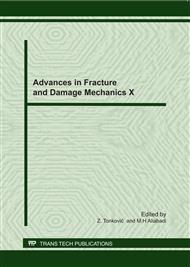p.379
p.383
p.387
p.391
p.395
p.399
p.403
p.407
p.411
Comparison of Solutions of Stress Field Based on Hertzian and Combined Numerical-Crystallographic Approaches Beneath Nanoindenter
Abstract:
Nanoindentation is considered to be a very promising experimental approach to measuring the ideal shear strength since the stressed volume beneath the sharp indenter may be defect-free. The local shear component of the stress reaches its maximum value at some close distance from the indenter in the bulk. The value of the stress can reach the ideal shear strength and, consequently become high enough to nucleate dislocations. This process might be detected as a pop-in on the nanoindentation load-displacement curve. To model the nanoindentation test for that purpose, three different approaches have been used in this works. The first approach is based on the analytical Hertzian solution of the stress field beneath the nanoindenter where only a continuum mechanics is taken into account. The second concept is based on the numerical solution without crystallographic considerations and the third one respects the fact that the dislocation generation in the substrate is subjected to crystallographic rules. The aim of this article is to compare all these concepts by their application to the nanoindentation process performed on selected bcc and fcc metallic substrates.
Info:
Periodical:
Pages:
395-398
Citation:
Online since:
September 2011
Authors:
Price:
Сopyright:
© 2012 Trans Tech Publications Ltd. All Rights Reserved
Share:
Citation:


